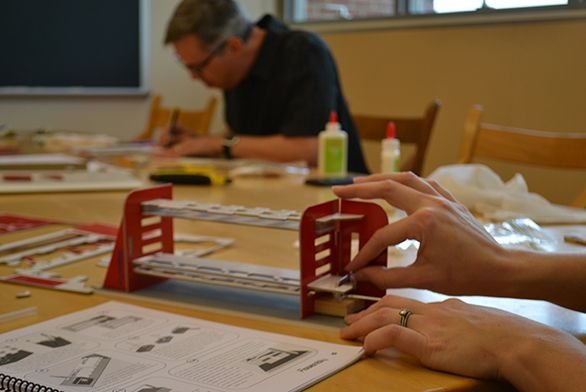The Philosophy of Technology
September 29, 2017 | By Tim Pratt

The advent of digital technology may have changed the way the world communicates, but its origins date back centuries.
This fall, students at St. John’s College are taking an in-depth look at that history, as well as the philosophy, effects, implications and other aspects of digital technology in a new preceptorial.
The course, for undergraduate and graduate students, began in August on the college’s Annapolis campus and is set to begin October 23 in Santa Fe.
The goal is to understand technology and computation in a basic way, from its origins to its implementation to its current and future effects, says Emily Langston, associate dean for graduate programs in Annapolis.
“We want to think about both the possibilities and what the limits of this technology might be,” Langston says. “It’s important to ask questions about its implications and to consider how the ongoing interactions we have with computers shape our own understanding of the world as we go about our daily lives.”
The preceptorials stem largely from the work of the college’s Mellon Foundation Study Group on Digital Technology, which spent the last two years studying digital technology and whether it has a place in St. John’s classrooms. Deans and faculty will meet after the fall semester to review the preceptorials and determine whether to incorporate digital technology lessons into upper-level math or lab.
“A thinking person needs to have a critique of technology,” says David McDonald, associate dean for graduate programs in Santa Fe. “That doesn’t mean a rejection. It just means a nuanced and thoughtful sense of what this thing is, so one doesn’t approach it unquestioningly or without reflecting on what it’s about, what it’s for, what it does for us, but also what it does to us.”
The preceptorial syllabi on the two campuses differ slightly, though the questions raised will be largely the same.
What is an electronic computer and how does it work? In what ways does it represent the rise of method and rationalization in the present era? What are the ethical and societal consequences of computing technology?
Students in Santa Fe will approach those questions first by studying the fundamentals of computing, then reading about the philosophy of technology.
Texts will include Charles Petzold’s Code: The Hidden Language of Computer Hardware and Software; selections from Holding on to Reality and Technology and Character of Contemporary Life by Albert Borgmann; and selections from Joseph Weizenbaum’s landmark text Computer Power and Human Reason: From Judgment to Calculation.
Along the way, students will learn the basics of writing computer code to better understand the powers and limitations of computing technology.
“I hope collectively we can think more about the way in which technological devices can affect our thinking and our relation to the world,” says tutor Eric Poppele, who is co-leading the Santa Fe preceptorial with McDonald.
In Annapolis, students are reading the works of several mathematicians and philosophers, including Gottfried Wilhelm Leibniz, Richard Feynman, Charles Sanders Peirce and Ada Lovelace. The most recent work is The Universe as a Quantum Computer by Seth Lloyd, published in 2013.
“Imagine going to Barnes & Noble, heading to the technology section, and picking one of the classics of technology. Then you St. John’s it,” says Annapolis Graduate Institute student Jose Miura. “That is what the Digital Technology Preceptorial is about.”
Students also are working with “digi-comps,” mechanical computers that demonstrate operations usually hidden in electronic circuits. That will show simple explanations of computer theory, binary numbers and programming.
Deans, faculty and students are excited about the possibilities.
“I am very happy to be part of this new class because I have been curious for a while now about what it would be like to apply what we do at St. John’s to books other than the great books,” Miura says. “I look forward to what fruit it bears in my life and in those of the other students.”

